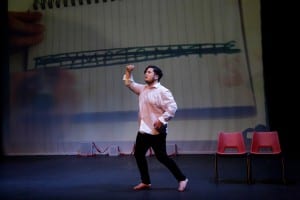Marketing for the arts and commercial marketing are two very different ideas. In the commercial sense, the marketing ‘dictates the nature of the product or service through conforming it to the requirements of the customer’ (Hill et al, 2003, 2). This is the main area in which it differs from arts marketing. Marketing for the arts does not dictate what the product should be but instead it takes influence and attempts to represent the work that the artist is creating. Instead of tailoring the work to what is being demanded in the market, it ‘needs to start with the product and find customers for it’ (Hill et al, 2003, 3) and I have done this for our company by finding out that our audience are highly engaged students based at the University of Lincoln.
It is important that the marketing materials for the company are coherent with the ideas that the creative team have for the performance. Whilst creating the image for the play, I had discussions with the company’s creative team so that I understood the direction that the play would be moving in. We decided that there were a few key elements that would definitely be integrated within the show. These included…
The importance of live music.
The use of projection.
Memory loss.
Science.
Michael Cahill as the main character.
A Colour scheme of red, blue, grey, white and black.
As we are still developing the final show, it is quite difficult to create an image that matches the artist’s intentions for the piece. Therefore, I used these characteristic as a design brief when creating the image.
My main idea was to use a double exposure effect on a photograph. I wanted the image to be of Michael who is playing ‘The Man’ in the performance. I took a lot of inspiration from the pictures below…



As our show is about memories and I wanted to show the complexity of what goes on inside our heads. The layering of the images helps to show this and it is also a really beautiful effect.
I had never tried to create this effect on photoshop before so I knew it was going to take me a few tries before I managed to get the right image.
Within our piece, another important element is music so I decided that one of the layers in the photo would be sheet music.
I liked the effect that it created but i didn’t like the colour scheme of the image. I also thought there needed to be more than one thing layered in the double exposure as it put too much focus on the sheet music and suggests our piece is mainly about music when it is only an element of it.
I preferred this image but the background needed to be a colour and there needed to be another image layered.
I then changed the image that was layered over the top and added the font. I really liked the image but once again, I wanted to add another layer over the top and wanted to try this with the sheet music I used previously. After some feedback on the image I also decided that the text was not bold enough and possibly needed to be further down on the image.
This is the final image with all of the information on it aswell. I like this image as I believe it portrays our performance well. I like the image of the light layered over the sheet music as we are using both music and projection within the piece and this hints at it. The font is bolder and the layering of the white font over the main image makes it stand out and look bold.
Work Cited-
Albi, A. (2013) Nature Boy. [electronic print] Available from https://www.flickr.com/photos/alessioalbi/9617537966/in/photostream/ [Accessed on 20 of April 2015].
Amamak Photograpy (2011) Sunshine On My Mind. [electronic print] Available from https://www.flickr.com/photos/artzyviv/6390297865/in/photostream [Accessed on 20 of April 2015].
Susan, H., O’Sullivan, C. and O’Sullivan, T. (2003) Creative Arts Marketing. 2nd edition. Oxford: Butterworth and Heinemann.
Tu, G. (2012) Wanderlust [electronic print] Available from: https://www.flickr.com/photos/gretatu/7432964390/in/photostream [Accessed on 20 of April 2015].
All images not cited were either taken or created by myself.






